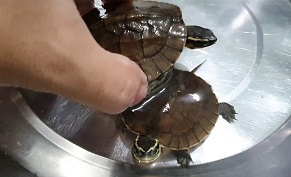South Asian Box Turtle (Cuora amboinensis)
Description: Also known as the Malayan box turtle. These turtles have blackish-brown to olive-brown colored shells that are not as ornate as many other box turtles. All have a blackish olive head with three yellow stripes on the side. The male can be identified by the slightly concave shape to its plastron. There is no specific pattern to what the underbellies may look like, for either sex. The only true way of telling age is to guess by the texture of the shell, as growth rings form irregularly.
Habitat: Unlike most box turtles, Malayan box turtles are extremely aquatic and prefer a warm, wet environment. They are specific to tropical rainforest areas, with a constant temperature between 75 and 95 degrees Fahrenheit, and are never found where temperatures dip below 70 degrees. C. amboinensis are the most aquatic of box turtles in the world, and because they prefer still, warm water, Malayan box turtles are found quite often in rice paddies, marshes, and shallow ponds in these tropical areas.
Range: In the Unietd States it is found in Texas. It has been seen and identified, but no research has been done in if this was a one off sighting or if there is actually a bredding population.
Malayan box turtles are found only in lowland tropical rainforest areas of Southeast Asia. Four subspecies of Cuora amboinensis occupy different areas within this region. These are C. a. couro, C. a. kamarona, C. a. lineata, and C. a. amboinensis. This habit of extreme habitat-specificity is unique in Asian box turtles, as most also range into alpine regions or areas north of the Tropic of Cancer.
Found in these States:
TX
Diet: They are omnivorous, with younger turtles tending towards more meat consumption and older turtles eating a more herbivorous diet.
Reproduction: Cuora amboinensis achieves fertilization internally by means of copulation between sexes. Mating occurs in the water. After copulation, females find a moist, well-drained area and dig a nest with their hind feet to lay the eggs in, which usually number from 1 to 5 spherical eggs per nest. The constant, warm temperature is beneficial for more frequent reproduction, and these turtles are capable of laying several nests per year. The incubation time is roughly 76 days between fertilization and hatching. A turtle is able to reproduce once it reaces the age of sexual maturity, which is at 4 or 5 years old.
Status: Cuora amboinensis is one of the most heavily traded species in Southeast Asia, captured from the wild in huge numbers to supply demand for pets, meat and for use in traditional medicines. Indonesia is the greatest source of this species and while there are quotas in place, these quotas are regularly exceeded.
»» Kingdom: Animalia - Animals
»» Phylum: Chordata - Chordates
»» Subphylum: Vertebrata - Vertebrates
»» Class: Reptilia - Reptiles
»» Order: Testudines - Turtles & Tortoises
»» Family: Geoemydidae - Leaf Turtles
»» Genus: Cuora
»» Species: Cuora amboinensis - South Asian Box Turtle
»» Subspecies: None
This article uses material from the Wikipedia article "Ambonia Box Turtle", which is released under the Creative Commons Attribution-Share-Alike License 3.0. Content may have been omitted from the original, but no content has been changed or extended.
|








